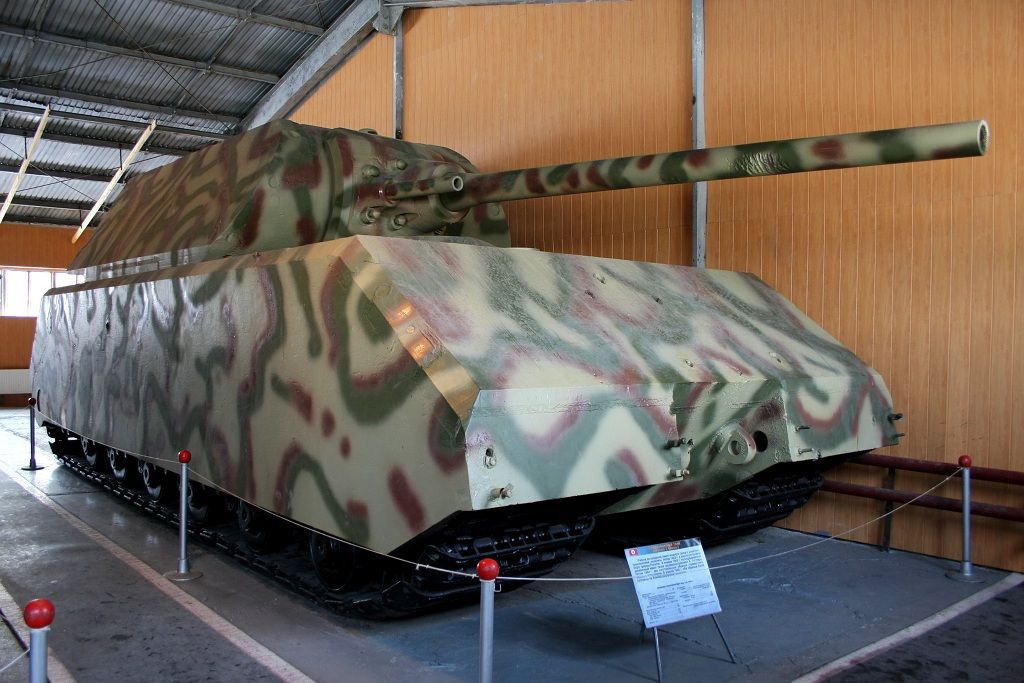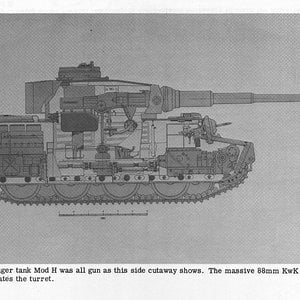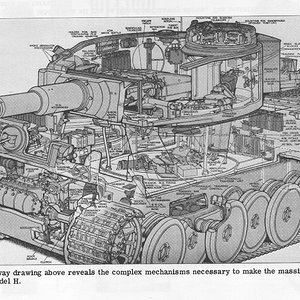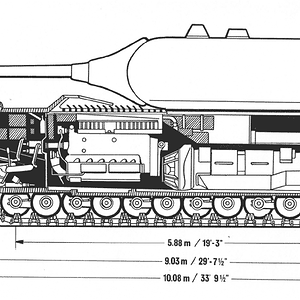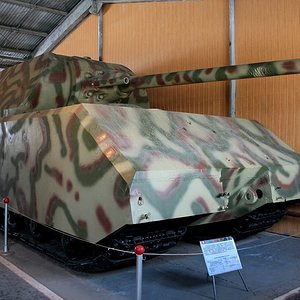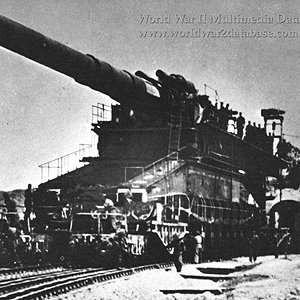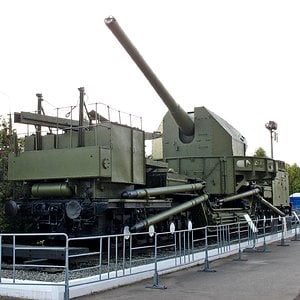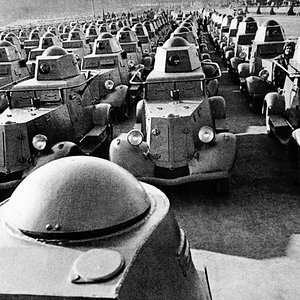Navigation
Install the app
How to install the app on iOS
Follow along with the video below to see how to install our site as a web app on your home screen.
Note: This feature may not be available in some browsers.
More options
Type Super-heavy tank
Place of origin Nazi Germany
Production history
Produced 1944
Number built 2 (of which 1 incomplete)
Specifications
Weight 200 metric tons (220.5 short tons)
Length 10.2 metres (33 ft 6 in)
Width 3.71 metres (12 ft 2 in)
Height 3.63 metres (11 ft 11 in)
Crew 6
--------------------------------------------------------------------------------
Armour 460 mm (18 in) (in the area of the mantlet)
250 mm (9.8 in) (mantlet)
240 mm (9.4 in) (turret front)
220 mm (8.7 in) (turret side and rear, and hull front)
210 mm (8.3 in) (turret front behind the mantlet)
190 mm (7.5 in) (hull side and rear)
Main
armament 128 mm (5 in) KwK 44 gun L/55
(32 rounds)
Secondary
armament 75 mm (3 in) KwK 44 gun L/36.5
(co-axial) (200 rounds)
7.92 mm MG34 machine gun
Engine MB 517 diesel engine
(V-shaped 12-cylinder)
1200 hp (895 kW)
Power/weight 6.4 hp/t
Ground clearance 500 mm (20 in)
Fuel capacity 2,700 litres (590 imp gal; 710 US gal) (internal fuel tank)
1,500 litres (330 imp gal; 400 US gal) (external fuel tank)
Operational
range 160 km (99 mi) (road)
62 km (39 mi) (off road)
Speed 13 km/h (8.1 mph)
Panzerkampfwagen VIII Maus was a German World War II super-heavy tank completed in late 1944. It is the heaviest fully enclosed armoured fighting vehicle ever built. Only two hulls and one turret were completed before the testing grounds were captured by the advancing Soviet forces.
These two prototypes (one with, one without turret) underwent trials in late 1944. The complete vehicle was 10.2 metres (33 ft 6 in) long, 3.71 metres (12 ft 2 in) wide and 3.63 metres (11.9 ft) tall. Weighing 200 metric tons, the Maus's main armament was a 128 mm KwK 44 gun (55 calibers long barrel), based on the 12.8 cm Pak 44 anti-tank artillery piece, with a coaxial 75 mm gun. The 128 mm gun was powerful enough to destroy all enemy armored fighting vehicles at close or middle ranges, and even some at ranges exceeding 3500 meters.[1]
The principal problem in development of the Maus was finding a powerful enough engine for its weight that could be carried in the tank. Though the design called for a maximum speed of 20 kilometres per hour (12 mph), no engine was found that could power the prototype to more than 13 kilometres per hour (8.1 mph) under ideal conditions. The weight also made it impossible to cross most bridges; it was intended to ford or submerge and use a snorkel to cross rivers.
Contents
1 Development
1.1 V1
1.2 V2
1.3 Flak
2 Capture
3 See also
4 References
5 External links
[edit] DevelopmentThe basic design known as the VK7001/Porsche Type 205 was suggested by Ferdinand Porsche to Adolf Hitler in June 1942, who subsequently approved it. The design up to then had been the culmination of work done by Porsche who had won the contract for the heavy tank that March. Work on the design began in earnest; the first prototype, to be ready in 1943 was initially to receive the name Mammut (Mammoth). This was reportedly changed to Mäuschen (Little Mouse) in December 1942 and finally to Maus (Mouse) in February 1943, which became the most common name for this tank. Its ordnance inventory designation was SdKfz 205.
Hitler's obsession with heavy tanks reached its zenith with the construction of the Panzer VIII "Maus". What is clear is that the time and energy spent on designing and producing these behemoths wasted a vast amount of precious design and production effort, which Nazi Germany could ill afford to spare. Guderian described the Maus as "this gigantic offspring of the fantasy of Hitler and his advisors."[2]
The Maus was designed from the start to use the "electric transmission" design which Ferdinand Porsche had used in his unsuccessful attempt to win the production contract for the Tiger. The initial prototypes used a gasoline engine, the later ones were to use diesel. It drove a massive electrical generator, and together they occupied the entire central rear two-thirds of the Maus' hull, cutting off the forward driver's compartment in the hull from direct access to the turret from within the tank. Each metre-wide track, which used the same basic "contact shoe" and "connector link" design format as the Henschel-built King Tiger had used, had its own electric motor mounted in the rear of the hull; the tracks had no direct mechanical connection to the internal combustion engine that powered the Maus.
Due to the uniquely wide tracks used (1100 mm each), there was a narrow lengthwise "tunnel" inside the hull under and to the rear of the turret to house the engine and generator of the tank's powertrain.[clarification needed]
The amount of armour was substantial, the hull front was 220 millimetres (8.7 in). The sides and rear of the hull were up to 190 millimetres (7.5 in). The turret armour was even thicker, the turret front was up to 240 millimetres (9.4 in) and the sides and rear 220 millimetres (8.7 in). The mantlet was 250 millimetres (9.8 in), and combined with the turret armour behind, the protection level at that section was even higher.
The initial plan for the Maus was for the prototype to have been completed by the summer of 1943, with monthly production scheduled to run at five vehicles per month after delivery of the prototype. The work on the Maus would be divided between Krupp, responsible for the chassis, armament and turret and Alkett, who would be responsible for final assembly.
The Maus tank was originally designed to weigh approximately 100 tons and be armed with a 128 mm main gun and a 75 mm co-axial secondary gun. Additional armament options were studied including various versions of 150 mm and 128 mm guns. Hitler himself in January 1943 insisted that the armament be a 128 mm main gun with a coaxial 75 mm gun.
By May 1943, a wooden mockup of the final Maus configuration was ready and presented to Hitler, who approved it for mass production, ordering a first series of 150. At this point, the estimated weight of the Maus was 188 tons. However, there is a story that concerns the main armament of the Maus being changed by Hitler who said that the 128 mm gun looked like a ´toy gun´ when compared to the tank, causing the 128 mm to be replaced by a 150 mm gun.
Place of origin Nazi Germany
Production history
Produced 1944
Number built 2 (of which 1 incomplete)
Specifications
Weight 200 metric tons (220.5 short tons)
Length 10.2 metres (33 ft 6 in)
Width 3.71 metres (12 ft 2 in)
Height 3.63 metres (11 ft 11 in)
Crew 6
--------------------------------------------------------------------------------
Armour 460 mm (18 in) (in the area of the mantlet)
250 mm (9.8 in) (mantlet)
240 mm (9.4 in) (turret front)
220 mm (8.7 in) (turret side and rear, and hull front)
210 mm (8.3 in) (turret front behind the mantlet)
190 mm (7.5 in) (hull side and rear)
Main
armament 128 mm (5 in) KwK 44 gun L/55
(32 rounds)
Secondary
armament 75 mm (3 in) KwK 44 gun L/36.5
(co-axial) (200 rounds)
7.92 mm MG34 machine gun
Engine MB 517 diesel engine
(V-shaped 12-cylinder)
1200 hp (895 kW)
Power/weight 6.4 hp/t
Ground clearance 500 mm (20 in)
Fuel capacity 2,700 litres (590 imp gal; 710 US gal) (internal fuel tank)
1,500 litres (330 imp gal; 400 US gal) (external fuel tank)
Operational
range 160 km (99 mi) (road)
62 km (39 mi) (off road)
Speed 13 km/h (8.1 mph)
Panzerkampfwagen VIII Maus was a German World War II super-heavy tank completed in late 1944. It is the heaviest fully enclosed armoured fighting vehicle ever built. Only two hulls and one turret were completed before the testing grounds were captured by the advancing Soviet forces.
These two prototypes (one with, one without turret) underwent trials in late 1944. The complete vehicle was 10.2 metres (33 ft 6 in) long, 3.71 metres (12 ft 2 in) wide and 3.63 metres (11.9 ft) tall. Weighing 200 metric tons, the Maus's main armament was a 128 mm KwK 44 gun (55 calibers long barrel), based on the 12.8 cm Pak 44 anti-tank artillery piece, with a coaxial 75 mm gun. The 128 mm gun was powerful enough to destroy all enemy armored fighting vehicles at close or middle ranges, and even some at ranges exceeding 3500 meters.[1]
The principal problem in development of the Maus was finding a powerful enough engine for its weight that could be carried in the tank. Though the design called for a maximum speed of 20 kilometres per hour (12 mph), no engine was found that could power the prototype to more than 13 kilometres per hour (8.1 mph) under ideal conditions. The weight also made it impossible to cross most bridges; it was intended to ford or submerge and use a snorkel to cross rivers.
Contents
1 Development
1.1 V1
1.2 V2
1.3 Flak
2 Capture
3 See also
4 References
5 External links
[edit] DevelopmentThe basic design known as the VK7001/Porsche Type 205 was suggested by Ferdinand Porsche to Adolf Hitler in June 1942, who subsequently approved it. The design up to then had been the culmination of work done by Porsche who had won the contract for the heavy tank that March. Work on the design began in earnest; the first prototype, to be ready in 1943 was initially to receive the name Mammut (Mammoth). This was reportedly changed to Mäuschen (Little Mouse) in December 1942 and finally to Maus (Mouse) in February 1943, which became the most common name for this tank. Its ordnance inventory designation was SdKfz 205.
Hitler's obsession with heavy tanks reached its zenith with the construction of the Panzer VIII "Maus". What is clear is that the time and energy spent on designing and producing these behemoths wasted a vast amount of precious design and production effort, which Nazi Germany could ill afford to spare. Guderian described the Maus as "this gigantic offspring of the fantasy of Hitler and his advisors."[2]
The Maus was designed from the start to use the "electric transmission" design which Ferdinand Porsche had used in his unsuccessful attempt to win the production contract for the Tiger. The initial prototypes used a gasoline engine, the later ones were to use diesel. It drove a massive electrical generator, and together they occupied the entire central rear two-thirds of the Maus' hull, cutting off the forward driver's compartment in the hull from direct access to the turret from within the tank. Each metre-wide track, which used the same basic "contact shoe" and "connector link" design format as the Henschel-built King Tiger had used, had its own electric motor mounted in the rear of the hull; the tracks had no direct mechanical connection to the internal combustion engine that powered the Maus.
Due to the uniquely wide tracks used (1100 mm each), there was a narrow lengthwise "tunnel" inside the hull under and to the rear of the turret to house the engine and generator of the tank's powertrain.[clarification needed]
The amount of armour was substantial, the hull front was 220 millimetres (8.7 in). The sides and rear of the hull were up to 190 millimetres (7.5 in). The turret armour was even thicker, the turret front was up to 240 millimetres (9.4 in) and the sides and rear 220 millimetres (8.7 in). The mantlet was 250 millimetres (9.8 in), and combined with the turret armour behind, the protection level at that section was even higher.
The initial plan for the Maus was for the prototype to have been completed by the summer of 1943, with monthly production scheduled to run at five vehicles per month after delivery of the prototype. The work on the Maus would be divided between Krupp, responsible for the chassis, armament and turret and Alkett, who would be responsible for final assembly.
The Maus tank was originally designed to weigh approximately 100 tons and be armed with a 128 mm main gun and a 75 mm co-axial secondary gun. Additional armament options were studied including various versions of 150 mm and 128 mm guns. Hitler himself in January 1943 insisted that the armament be a 128 mm main gun with a coaxial 75 mm gun.
By May 1943, a wooden mockup of the final Maus configuration was ready and presented to Hitler, who approved it for mass production, ordering a first series of 150. At this point, the estimated weight of the Maus was 188 tons. However, there is a story that concerns the main armament of the Maus being changed by Hitler who said that the 128 mm gun looked like a ´toy gun´ when compared to the tank, causing the 128 mm to be replaced by a 150 mm gun.

